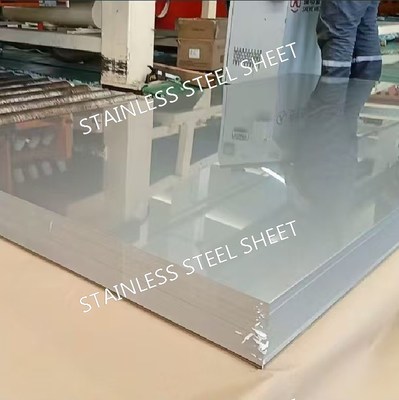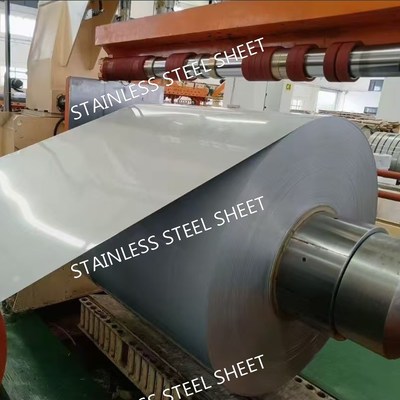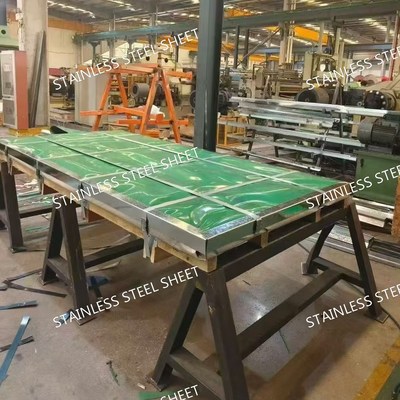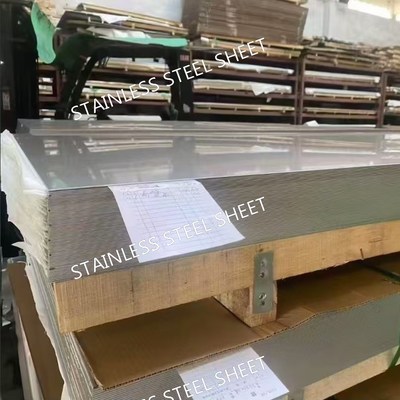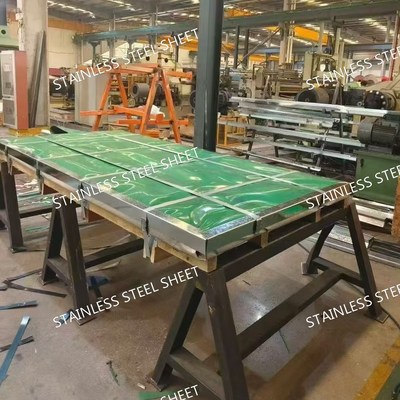-
Bande d'acier inoxydable
-
Feuille d'acier inoxydable
-
Plaque d'acier inoxydable
-
tuyau d'acier inoxydable
-
Barre d'acier inoxydable
-
Bobine en acier galvanisée
-
Plaque d'acier
-
barre ronde en acier
-
alliage de nickel
-
Tuyau d'acier sans couture
-
Poutre d'acier inoxydable
-
Feuille de plat de cuivre
-
Barre ronde de cuivre
-
 Raian IonescuQualité matérielle très bonne. nous avons pour coopérer plus de 10 ans. Ils commercent des genres de sorts de matériel en acier. Toute la qualité matérielle bonne. Ils devoir pour toute la qualité matérielle. Nous surfaçons pour continuer à coopérer avec eux à l'avenir
Raian IonescuQualité matérielle très bonne. nous avons pour coopérer plus de 10 ans. Ils commercent des genres de sorts de matériel en acier. Toute la qualité matérielle bonne. Ils devoir pour toute la qualité matérielle. Nous surfaçons pour continuer à coopérer avec eux à l'avenir
Tôle en acier inoxydable 254SMO Résistant à la corrosion, plaque en alliage à haute résistance
| Lieu d'origine | Chine |
|---|---|
| Nom de marque | BAOSTEEL TISCO |
| Certification | ISO |
| Numéro de modèle | 254SMO |
| Quantité de commande min | 50 kg |
| Prix | 7 - 10 USD/Kg |
| Détails d'emballage | Emballage standard pour l'exportation |
| Délai de livraison | 5 - 12 jours en fonction de la quantité |
| Conditions de paiement | LC, T/T, Western Union |
| Capacité d'approvisionnement | 20 tonnes par semaine |

Contactez-moi pour des aperçus gratuits et des bons.
Whatsapp:0086 18588475571
Wechat: 0086 18588475571
Skype: sales10@aixton.com
Si vous avez n'importe quel souci, nous fournissons l'aide en ligne de 24 heures.
x| Produits | feuille d'acier inoxydable | Grade | 254SMO |
|---|---|---|---|
| Épaisseur | 1,0-80,0 mm | Technologie | laminé à froid, laminé à chaud, forgé |
| Largeur | 1000mm 1219mm 1500mm ou coutumes comme demande | Surface | 2B BA No.1 |
| Standard | EN DIN D'ASTM GIGAOCTET JIS | MOQ | 1 tonne |
| Mettre en évidence | Feuille de l'acier inoxydable 254SMO,plaque en acier inoxydable résistant à la corrosion,tôle en acier allié à haute résistance |
||
Tôle en acier inoxydable 254SMO Résistante à la corrosion, plaque en alliage à haute résistance
Spécifications des tôles en acier inoxydable
| Nom | Tôle en acier inoxydable 254SMO |
| Notre nuance |
Série 200 : 201 202 Série 300 : 301 304,304L,304H,309S,310S,314,316L,316Ti,316H,316LN,317L,321,329,347 Série 400 : 409L,410,410S,416,420,430,431,436L.439,441,443,444,445,446 Super acier inoxydable : 904L,926,254SMO,654SMO,15-5PH,17-4PH,17-7PH.etc Alliage de nickel : C276, C22,G35,Alliage X,Monel 400,K500,Inconel 600,601,617,625,718,Incoloy 800,800H,800HT,825.etc |
| Technique | Laminé à chaud, laminé à froid, forgé |
| Norme | JIS, AISI, ASTM, DIN, TUV, BV, SUS, etc. |
| Épaisseur | 0,1 – 80,0 mm |
| Plage de largeur | 10 mm – 2 000 mm |
| Longueur | Personnalisée |
| Finition | 2B, BA, No.4, 8k, Brossé, Cheveux, Revêtement PVD, Sablé |
| Service | Découpe laser, pliage |
| Échantillon | Disponible |
Tôle en acier inoxydable 254SMO Résistante à la corrosion, plaque en alliage à haute résistance
Caractéristiques principales : Résistance à la corrosion redéfinie
Résistance à la corrosion par piqûres et fissures
Résistance à la fissuration par corrosion sous contrainte (SCC)
Résistance à la corrosion uniforme
Propriétés mécaniques : la résistance rencontre la ténacité
Indicateurs de performance mécanique clés
| Propriété | Spécification (recuit de mise en solution) |
|---|---|
| Résistance à la traction | ≥ 620 MPa (min) ; Typique 650 MPa |
| Limite d'élasticité (0,2 % de décalage) | ≥ 300 MPa (min) ; Typique 320 MPa |
| Allongement | ≥ 35 % |
| Dureté Brinell (HB) | ≤ 270 |
| Densité | 8,0–8,1 g/cm³ |
| Point de fusion | 1 320 °C |
| Plage de température de fonctionnement | -50 °C à 300 °C |
Résistance comparative par rapport aux aciers inoxydables courants
| Nuance d'alliage | Résistance à la traction (MPa) | Limite d'élasticité (MPa) | Valeur PRE | Résistance aux chlorures |
|---|---|---|---|---|
| 316L | 485–655 | ≥ 170 | ≈ 25 | Modérée |
| 2205 Duplex | 620–850 | ≥ 450 | ≈ 35 | Bonne |
| 254SMO | ≥ 620 | ≥ 300 | ≥ 42 | Excellente |
Composition chimique : la science derrière la performance
| Élément | Plage de teneur (pourcentage en masse) |
|---|---|
| Carbone (C) | ≤ 0,02 % |
| Manganèse (Mn) | ≤ 1,0 % |
| Silicium (Si) | ≤ 0,8 % |
| Chrome (Cr) | 19,5–20,5 % |
| Nickel (Ni) | 17,5–18,5 % |
| Molybdène (Mo) | 6,0–6,5 % |
| Azote (N) | 0,18–0,22 % |
| Phosphore (P) | ≤ 0,040 % |
| Soufre (S) | ≤ 0,030 % |
| Cérium (Ce) | 0,03–0,08 % |
| Fer (Fe) | Équilibre |
- Le chrome et le molybdène forment une couche d'oxyde dense et protectrice à la surface, empêchant les agents corrosifs de pénétrer dans le métal de base.
- Le nickel stabilise la microstructure austénitique, améliorant la ductilité et la ténacité.
- L'azote agit comme un agent de renforcement, augmentant la résistance à la traction et la limite d'élasticité sans compromettre la ductilité.
- La faible teneur en carbone empêche la formation de carbures de chrome pendant le traitement thermique ou le soudage, éliminant les risques de corrosion intergranulaire.
Spécifications et options de personnalisation
Spécifications standard
| Paramètre | Plage |
|---|---|
| Épaisseur | 0,1 mm – 300 mm |
| Largeur | 50 mm – 3 500 mm |
| Longueur | 1 m – 12 m (longueurs personnalisées disponibles) |
| Tailles standard (mm) | 1 000 × 2 000, 1 220 × 2 440, 1 500 × 3 000, 2 000 × 4 000 |
| Finitions de surface | Laminé à chaud (HR) Décapé et recuit (No. 1), Laminé à froid (CR) 2B, 2D, Recuit brillant (BA), Satiné, Poli |
| Conformité aux normes | ASTM A240, ASME SA240, EN 1.4547, UNS S31254, GB/T 3280 |
| Certifications | Certificat d'essai en usine (MTC), rapports sur les propriétés chimiques et mécaniques |
Capacités de personnalisation
- Épaisseurs non standard (0,15 mm – 300 mm) et dimensions pour s'adapter aux conceptions d'équipement spécifiques.
- Finitions de surface spéciales (par exemple, polissage miroir, brossé) pour des besoins esthétiques ou fonctionnels.
- Services de coupe sur mesure pour minimiser les déchets et réduire le temps de traitement sur site.
- Assistance au soudage et à la fabrication, y compris les consommables de soudage à base de Ni recommandés (par exemple, l'alliage 625, ERNiCrMo-3) pour maintenir la résistance à la corrosion dans les joints soudés.
Applications industrielles : où le 254SMO excelle
Génie maritime et offshore
- Plates-formes offshore : plaques de pont, systèmes de tuyauterie et composants structurels exposés à l'eau de mer et aux embruns salés.
- Construction navale : revêtement de coque, ballasts et systèmes de refroidissement à l'eau de mer.
- Équipement sous-marin : collecteurs, connecteurs et colonnes montantes qui fonctionnent dans des environnements à haute pression et à forte teneur en chlorures.
Usines de dessalement
- Systèmes d'osmose inverse (OI) : récipients sous pression, membranes et tuyauteries qui traitent la saumure concentrée.
- Systèmes d'admission et de refoulement d'eau de mer : composants résistants au biofouling et à la corrosion par les chlorures.
Pétrochimie et transformation chimique
- Raffineries : échangeurs de chaleur, condenseurs et tuyauteries pour le traitement du pétrole brut et la récupération des acides.
- Réacteurs chimiques : récipients manipulant des milieux agressifs tels que l'acide sulfurique, l'acide chlorhydrique et les solvants chlorés.
- Désulfuration des gaz de combustion (FGD) : gaines, épurateurs et éliminateurs de brouillard exposés aux sous-produits corrosifs de SO₂.
Transformation des aliments et des produits pharmaceutiques
- Équipement pour la transformation des aliments acides (par exemple, tomates, agrumes) et des agents de nettoyage corrosifs.
- Fabrication pharmaceutique : récipients et tuyauteries nécessitant une grande pureté et une résistance aux produits chimiques de stérilisation.
Industrie des pâtes et papiers
- Digesteurs, usines de blanchiment et chaudières de récupération manipulant des produits chimiques corrosifs (par exemple, dioxyde de chlore, soude caustique).
Avantages par rapport aux alliages conventionnels
Résistance supérieure à la corrosion
- Surpasse le 316L et le 2205 dans les environnements riches en chlorures, réduisant les coûts de maintenance et prolongeant la durée de vie.
- Élimine le besoin d'inhibiteurs de corrosion ou de revêtements protecteurs coûteux dans de nombreuses applications.
Rentabilité
- Sert d'alternative viable aux alliages à base de nickel (par exemple, l'alliage 625) et au titane, offrant des performances similaires à un coût inférieur.
- Réduit les temps d'arrêt et les coûts de remplacement grâce à sa longue durée de vie et à sa résistance aux défaillances prématurées.
Aptitude au traitement polyvalente
- Bonne soudabilité avec des consommables appropriés, permettant des fabrications complexes.
- Propriétés de travail à froid et à chaud acceptables, permettant le pliage, le formage et l'usinage (avec des outils appropriés pour sa résistance plus élevée).
Performances fiables à toutes les températures
- Maintient la ténacité dans des conditions cryogéniques (-50 °C) et la stabilité dans des applications à haute température jusqu'à 300 °C.
- Résiste à la fatigue thermique dans les systèmes avec des fluctuations de température fréquentes.
Consignes d'installation et d'entretien
Pratiques de soudage
- Utilisez des consommables de soudage à base de Ni (par exemple, ERNiCrMo-3, Alloy 625) pour correspondre à la résistance à la corrosion de l'alliage.
- Effectuez un traitement thermique post-soudure (recuit de mise en solution à 1 100 °C suivi d'une trempe à l'eau) pour restaurer la microstructure du matériau et éliminer la sensibilisation induite par le soudage.
Conseils d'usinage
- Le 254SMO est plus difficile à usiner que le 316L en raison de sa résistance plus élevée. Utilisez des outils en acier rapide (HSS) ou en carbure avec des arêtes de coupe vives.
- Appliquez une lubrification adéquate et des vitesses de coupe modérées pour éviter l'écrouissage.
Nettoyage et entretien
- Retirez rapidement les contaminants de surface (huiles, graisses, projections de soudure) à l'aide de détergents doux ou de nettoyants pour acier inoxydable.
- Évitez tout contact avec l'acier au carbone pendant le stockage ou l'installation, car cela peut provoquer une corrosion galvanique.
- Inspections régulières (visuelles ou par essais non destructifs) pour détecter rapidement tout signe de corrosion ou de dommage mécanique.
Conclusion
![]()
![]()
![]()
![]()




